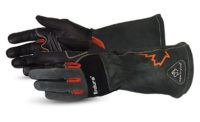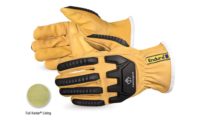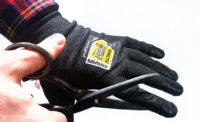It doesn’t happen all at once. It starts one day when you notice the sun setting earlier than you remember. Then you need to put on a jacket when you leave the house in the morning. From there it turns into seeing your breath when you exhale, warming the car up and the dreaded thought of shoveling snow.
Like it or not, winter will be here soon. But when it comes to dressing up for the outdoors there’s a few important factors that you need to consider.
This article has pertinent information to help you make the best hand protection choices. Information that will help you stay warm during those wet and wintry work days.
Dry hands = happy hands
Moisture on your skin is the fastest way to ruin your winter work day. It could be moisture penetrating through your glove or sweat building up inside it. Either way, moisture inside your glove will alter your body temperature. As it drops, you'll feel cold and the muscles in your hands will begin to constrict, making them harder to move.
Moisture can lead to frost nip, frostbite and, in extreme cases, hypothermia. If you’re working in wet and slushy conditions, consider hand protection with built-in water resistance. If you’re doing physically demanding work or if you’re prone to sweating, the type of insulation that you choose will be important in maintaining dry, happy hands.
Choose the right insulation
Choosing the right type of insulation is important but it will depend on the tasks that you’re doing. As a general rule, the more thermal insulation a glove provides, the thicker it will be.
One of the more basic options for a winter glove liner is boa acrylic. This option will be one of the warmest but comes with a lot of bulk.
If sweat is a concern, you'll want to look at insulation like fleece or Thinsulate™. Designed to wick moisture away from your skin, both options dry fast. The major difference is thickness. It takes more layers of fleece to offer the same thermal insulation of a fabric such as Thinsulate™.
The bottom line: When it comes to choosing insulation, the type of job you're doing is crucial. If it's particularly cold or dexterity is crucial, Thinsulate™ is your best option. But you will pay more.
Fleece and boa acrylic are excellent if dexterity isn't as important, the work isn't as demanding or it isn't sub-zero temperatures. These options will also be friendlier to your wallet.
Get the right size glove
The proper fit is always important when it comes to hand protection. A poor fitting glove becomes extra noticeable when the mercury starts to drop. If your glove is too big, it can be hard to maneuver in and allows more air to enter, cooling your hands down. If your glove is too small, it can restrict movement and won’t effectively cover your hand, leaving your wrist exposed.
How to ensure you have the proper fit
Using a ruler, measure the width of your hand from the base of your index finger to the base of your pinky finger. If your hand is two inches across at this part of the hand, you’ll need an XXS or size 5 glove. Sizes increase by a half inch. A sizing guide can be downloaded at http://www.superiorglove.com/pages/work-gloves-101/sizing/.
Consider a palm coating
There’s nothing more frustrating on a winter day than trying to do a simple task at work and failing because of poor grip. Palm coatings are a simple way to increase your grip without breaking the bank.
Not any palm coating will do. You’ll want to look for options like PVC or nitrile, which won’t crack in cold weather. Both glove coatings are available in micropore versions.
A special treatment in the PVC/nitrile solution creates tiny craters throughout the coating. These craters act as a suction cup to displace liquids and giving you stronger grip.
Don’t forget about wind chill
Your glove manufacturer should be able to provide a glove's temperature rating. This rating tells you the thermal insulation properties of a glove. I.e. if you're working in 5°F, a glove rated for 14°F won't keep you warm enough. But a glove rated for -49°F may be overkill.
Don't forget to consider wind chill when determining the weather you're working in. It might average 14°F in your area during winter, but 25-mile-per-hour winds will make it feel closer to -5°F.
This means that a glove rated for mild temperatures will be ineffective, leaving you shivering.
Gloves vs. mitts
There’s a reason that your parents dressed you in mitts instead of gloves as a kid – they keep you warmer.
A roomful of people will be warmer than a room with just one person. A mittful of fingers will generate more heat than four fingers and a thumb in individual sections.
Bottom line: Choose mitts instead of gloves if you’re working in extreme sub-zero conditions like North Dakota or Antarctica.
Dress in layers
Sometimes an extra layer is helpful if your winter gloves aren’t quite warm enough. Other times another layer can be used if you have the perfect glove but it isn’t winterized.
If your glove is durable, cost effective, comfortable, and protects you from the hazards you face on a regular basis, you might not want to spend all that time looking for a winter option. In these situations, a glove liner can be the perfect addition.
These lightweight layers are great because they:
- Wick moisture from your hand.
- Increase thermal insulation.
- Are easily cleaned.
If you decide to go this route, consider going up a size in your non-winterized to glove to keep your hands comfortable; i.e. if you normally wear a medium, you’ll want to wear a large glove overtop of the liner.
Conclusion
You may not need to consider all seven factors when you’re choosing the perfect winter work glove. But by looking at the tasks that you’re performing, it will be easier to decide which insulation is be best, whether you need to choose a glove or mitt and if a palm coating is necessary.
These seven simple steps can be the difference between a wet, miserable winter and a warm, enjoyable one.








